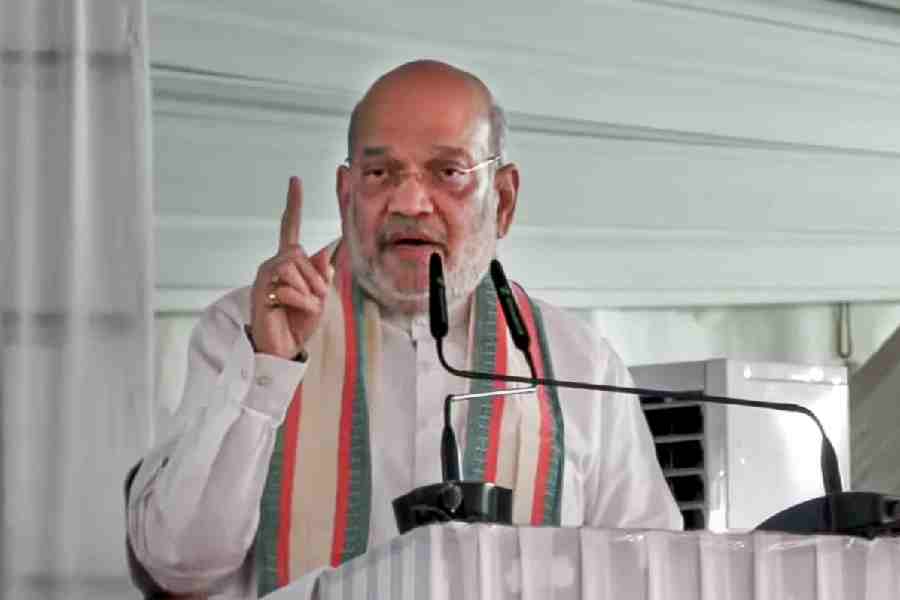 |
| Pierce Brosnan, who stars in Die Another Day |
Mumbai, Dec. 28: It may not be time yet for Shah Rukh Khan and Aishwarya Rai to walk shoulder to shoulder with placards saying “Stop cultural imperialism, save Bollywood jobs”, but the Hindi film industry is shaken by what is unfolding like the opening sequence of Hollywood’s Indian conquest.
In a year that has been dubbed Bollywood’s darkest, Hollywood studios have notched up hit after hit on Indian soil, raising fears that, after Coke and McDonald’s, Spiderman and Bond could be the future agents of America’s cultural colonising.
India-based US studios are strutting their stuff. The Bond movie, Die Another Day, from 20th Century Fox, opened last week to record collections for an English-language film: Rs 5.35 crore in the first three days.
Creeping up close behind is Spider-Man from Columbia: it had soared to the top in its opening weekend at Rs 5.3 crore and collected Rs 28 crore in its stint in India. Another Columbia presentation, XXX, the Vin Diesel action movie, grossed Rs 16 crore. The low-budget UK-made Bend It Like Beckham (distributed by Columbia) did a business of Rs 6.5 crore.
The Bond film is expected to reach box office heights that even Spiderman didn’t dare. The Guru, recently released, is also doing exceptionally well.
Contrast that with what Bollywood has on show: two hits, Raaz and Devdas. Only Raaz qualifies as a major hit — made at Rs 4.5 crore, it did business worth Rs 25 crore. The Rs 50-crore Devdas is said to have recovered its cost.
At the same time, Columbia TriStar, with its sister distribution division SPE Films India Limited, has proudly announced that it has crossed the Rs 1-billion-mark in gross box office ticket sales this year by end-November.
“There have been big Hollywood grossers that did better than Indian films, like Jurassic Park and Titanic,” says Taran Adarsh, trade analyst. “But never before did the Indian film industry lag behind Hollywood so much as in this year,” he adds.
Is it the beginning of the Hollywood whitewash, like it happened in Europe, and particularly France, where the opposition to what many see as American cultural colonialism is also the strongest?
Many industry insiders feel the tremors, but say it has as much to do with Bollywood failures as Hollywood’s marketing policy.
“Hollywood can’t be stopped,” says director Govind Nihalani. He says there are two things in favour of Hollywood, the first being the might of the American studios. “We can’t make a Titanic here. But at the end of the day, it is we, the filmmakers, who are to blame.”
This year’s dismal collections, says Nihalani, are due to the failure of popular cinema, prompted by a “total bankruptcy of the imagination”.
“Audiences are not excited by us anymore. Their tastes have changed.”
Perhaps their tastes have changed because of exposure to Hollywood and world media through television, but it is into this gap that Hollywood has stepped in, with a very effective strategy.
While Hollywood was able to establish a permanent dominance over the French market as a result of the collaboration between US policy makers, corporate interests and market-opening measures like the Blum Burns accord and the global negotiations on trade (under Gatt), where cinema was a key subject, in India the success formula has been much simpler: going vernacular.
It is now expected that a Hollywood blockbuster will be dubbed into three languages: Hindi, Tamil and Telugu. That way, Hollywood, like Coke, has penetrated “real India”, not only small towns, but also rural belts.
The dubbed versions have been doing the rounds since the “Jurassic” age, but now they are being done in greater numbers. “About 30 to 40 prints of Spider-Man were dubbed into Hindi, Tamil and Telugu each,” says Amit Shetty of Kwality, a dubbing studio.
Hollywood studios are also unleashing a greater number of prints: Die Another Day was released through 262 prints (198 of them in Hindi, Tamil and Telugu), a record for an English film in India, but still far lower than the Bollywood average of 500.
“Hollywood is releasing the films faster than before,” says scriptwriter Anurag Kashyap, who worked on Satya. “While it was unthinkable a few years back, now some of these films are released in India on the same date as the world premiere,” he adds.
Hollywood carefully picks its films that are to be dubbed, says film critic Amrit Gangar. “Only films with such ‘universal’ themes like Spiderman, which would be understood by the masses, are dubbed into Indian languages,” he says.
Kashyap, too, sees a conscious Hollywood strategy to take over the Indian market. “People here are fed up with Hindi films. Why won’t Hollywood target India? There is a huge market of a 1 billion-plus bored population,” says Kashyap.
“They would rather watch a Hindi Bond film than another music video-style wedding movie. The old formula is just not working.”
At a seminar, filmmaker Mahesh Bhatt warned that the talk about Bollywood storming the world market should be taken with handfuls of salt. Hindi films are mostly popular in the Indian diaspora, not generally, he said.
“We should remember that the average filmgoer in the US is not interested in Indian films. There is this great hype about India going to the Oscars,” Bhatt said. “But given the reception to our films so far, it’s more likely that the US is selling the Oscars to India, and not India to the Oscars,” he added.











